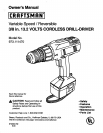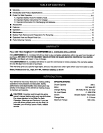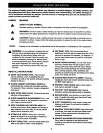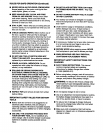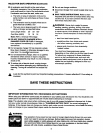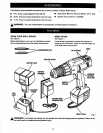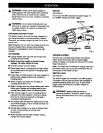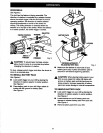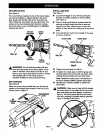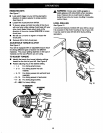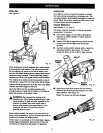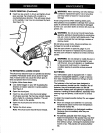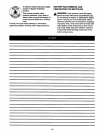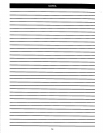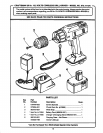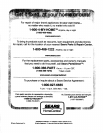
DRILLING
See Figure 11.
OVERLOAD
Your drill has a built-in overload protsctor to protect
the motor during overloading or prolonged use. The
overloed protector automatically activates to break the
circuit. When this occurs, allow your drillto cool a few
seconds before resuming operation.
CHUCK REMOVAL
See Figures 12, 13, and 14.
The chuck must be removed in order to use some
accessories. To remove:
• Lock switch trigger on your drill by placing the
direction of rotation selector in center position.
See Figure 2.
• Insert a 5/16 inchor larger hex key wrench intothe
chuck of your drilland tightenthe chuckjaws
securely.
• Tap the hex key wrench sharply with a mallet in a
clockwise direction. See Figure 13. This will
loosen the screw in the chuck for easy removal.
Fig. 11
When ddllinghard smooth surfaces use a canter punch
to mark desired hole location.This willprevent the ddll
bitfrom slippingoff center as the hole is started. How-
ever, the lowspeed feature allows startingholes without
center punching ifdesired. To accomplishthis, simply
operate your drillat a lowspeed untilthe hole isstarted.
The matedal to be ddlledshouldbe secured in a vise or
with clamps to keep itfrom tuming as the ddllbit rotates.
Hold toolfirmlyand place the bit at the point to be ddlled.
Depress the switchtriggerto starttool.
Move the ddnbit intothe workpisce applying only
enough pressure to keep the bit cutting. Do not force or
apply side pressure to elongatea hole.
WARNING: Be prepared for binding or bit
breakthrough. When these situations occur, drill
has a tendency to grab and kick opposite to the
direction of rotation and could cause lossof
control when breaking through material. If not
prepared, this loss of control can result in
possible serious injury.
When drilling metals, use a light oil on the ddll bit to
keep it from overheating. The oil will prolong the life of
the bit and increase the drilling action.
If the bit jams in workpiece or ifthe drill stalls, release
switch trigger immediately. Remove the bit from the
workpiece and determine the reason for jamming.
KEYLESS
CHUCK
\
MALLET
CHUCK
JAWS
.HEX KEY
WRENCH Fig. 12
Open chuck jaws and remove hex key wrench.
Remove the chuck screw by'tuming it in a clock-
wise direction. See Figure 13.
Note: The screw has left hand threads.
Fig. 13
11



